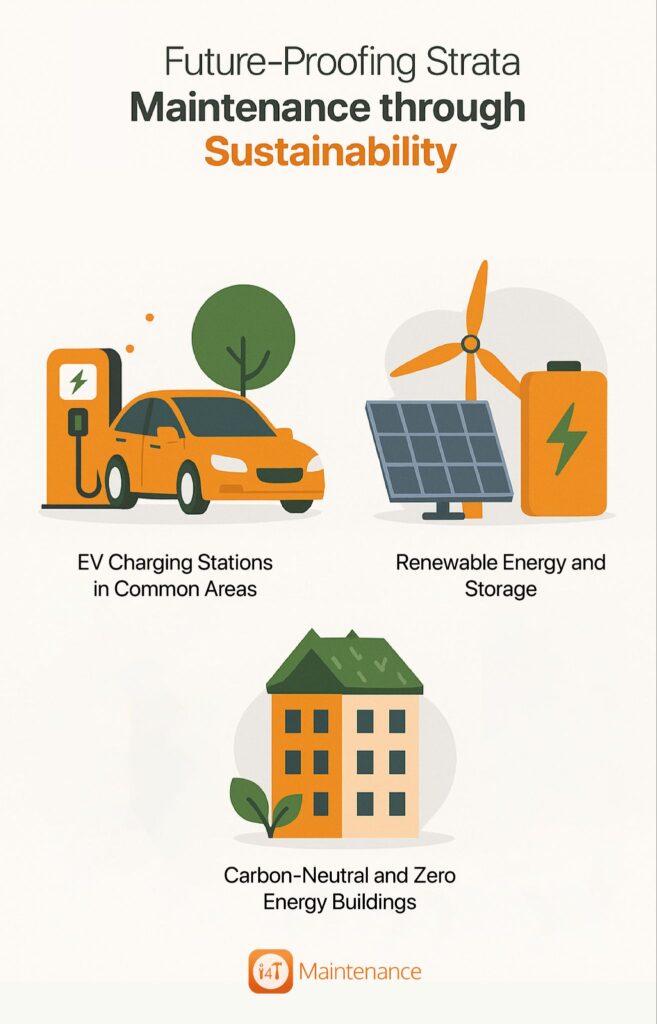Strata managers in Australia are facing a growing need to address sustainability in their maintenance practices. With climate change concerns, rising utility costs, and stricter environmental regulations, strata schemes must adapt to stay compliant and cost-effective.
As pressures mount, strata managers are taking on new responsibilities, from improving energy efficiency to ensuring water conservation and waste management.
With the push for greener, more sustainable buildings, these trends are reshaping how maintenance is planned and executed.
Let’s take a look at the key sustainability trends influencing strata maintenance in Australia and how they are changing the way strata managers approach their work.
1. Energy Efficiency and Carbon Footprint Reduction
Improving energy efficiency is a key way strata schemes in Australia are cutting costs and reducing their environmental impact.
Solar Power
Many buildings are now adding solar panels to their rooftops. Solar energy can power common areas like lights, lifts, and air conditioning. This reduces the need for grid electricity, lowering both energy bills and carbon emissions.
Energy-Efficient Lighting
Strata managers are upgrading to LED lights in common areas. LEDs use less power and last longer than regular bulbs. Motion sensors and timed lighting ensure that lights are only on when needed, saving even more energy.
HVAC System Maintenance
Heating and cooling systems (HVAC) use a lot of energy. Regular maintenance, like cleaning filters and fixing leaks, helps these systems run smoothly and efficiently. Some buildings are also switching to energy-efficient HVAC systems, which use less power and reduce emissions.
Smart Technologies
More buildings are using smart systems to manage energy. Energy management systems (EMS) track energy use in real-time and adjust heating, cooling, and lighting as needed. IoT sensors also provide data to help managers make better decisions about saving energy.
NABERS Ratings
Many strata schemes aim to improve their NABERS energy ratings. NABERS rates buildings on their environmental performance, including energy use. A higher rating shows that a building is using energy more efficiently, and is a great way to attract eco-conscious tenants.
Energy efficiency practices help strata schemes lower energy costs and reduce their carbon footprint, making buildings more sustainable and cost-effective for the future. .
2. Water Conservation and Management
Water conservation is an important focus for strata schemes in Australia. Here’s how some buildings are managing water use more efficiently:
Smart Irrigation Systems
Strata schemes are using smart irrigation systems in gardens. These systems adjust watering based on weather and soil moisture, ensuring that plants only get the water they need. This reduces water waste and helps save on water bills.
Regular Plumbing Audits
Strata managers are carrying out plumbing audits to check for leaks and ensure water is being used efficiently. Catching problems early prevents water wastage and helps meet BASIX water requirements, which are part of building standards in Australia.
Rainwater Harvesting and Water-Saving Devices
Many buildings are also installing rainwater harvesting systems to collect rainwater for use in gardens or toilets. Adding water-saving devices like low-flow taps and dual-flush toilets in common areas helps reduce overall water use.
These simple steps help strata schemes save water, reduce costs, and improve sustainability.
3. Waste Management and Recycling Innovations
Strata schemes are focusing on better ways to manage and recycle waste. Let’s look at how they’re improving waste practices:
Waste Separation Systems
Many strata buildings are setting up waste separation systems to make recycling easier. By using bins for recyclable materials, general waste, and organic waste, it’s simpler for residents to sort their rubbish properly. This helps increase recycling rates and reduces contamination.
Regular Maintenance of Waste Systems
Strata managers are regularly checking and maintaining waste disposal systems and bin areas to ensure they meet local council regulations and waste management policies. This includes keeping bins in good condition, ensuring they are easy to access, and making sure waste is picked up on time. Proper maintenance helps avoid waste build-up and keeps everything running smoothly.
Organic Waste Diversion
Strata schemes are also introducing organic waste bins for things like food scraps and garden waste in common areas. Diverting organic waste from landfills helps reduce their environmental impact. This waste can be composted or used to create energy or fertiliser.
These steps help strata schemes manage waste more efficiently, meet local rules, and reduce their environmental footprint.
4. Use of Sustainable Materials and Green Building Practices
There is a growing trend towards using sustainable materials and eco-friendly building practices in strata schemes.
Low-VOC and Sustainable Cleaning Products
Strata managers are switching to low-VOC cleaning products that release fewer chemicals into the air. These products are better for both the environment and the health of residents and maintenance staff. By using these eco-friendly cleaners, strata buildings can improve indoor air quality and reduce pollution.
Eco-Friendly Materials in Refurbishments and Repairs
When doing repairs or refurbishments, many strata buildings are choosing eco-friendly materials. This includes using recycled materials, non-toxic paints, and locally sourced products. These choices help reduce the building’s environmental impact and make it more sustainable in the long term.
Green Roofs and Green Walls
In city areas, some strata schemes are adding green roofs or green walls. These features improve air quality, reduce heat in urban areas, and make buildings look better. Green roofs also help with insulation, reducing the need for heating and cooling, while green walls can improve energy efficiency and reduce water runoff.
By using these sustainable materials and practices, strata schemes can reduce their environmental impact and improve the overall sustainability of their buildings.
5. Integration of Smart Technologies for Sustainability
Smart technologies are making strata buildings more efficient and sustainable. Here’s how some of these work:
IoT Devices to Monitor and Optimise Resources
Modern strata buildings are using Internet of Things (IoT) devices to track energy, water, and waste use in real-time. These smart sensors help identify where resources are being wasted and allow managers to make adjustments to save energy and reduce costs.
Predictive Maintenance Systems
Predictive maintenance systems use data to predict when equipment like heating, cooling, or lifts might fail. This allows strata managers to plan repairs before problems occur, helping avoid costly breakdowns and extending the life of the equipment.
Automation for Lighting, Temperature, and Waste
Automation systems control things like lighting, heating, cooling, and waste management. For example, lights can turn off automatically in empty rooms, and heating or cooling can adjust based on usage. These systems help reduce energy use and improve sustainability in real-time.
These smart technologies are helping strata schemes save money and use resources wisely.
6. Strata Compliance with Environmental Regulations
Strata schemes in Australia need to follow environmental rules to stay compliant and reduce their environmental impact. Here’s how they do it:
Following State-Based Sustainability Regulations
Strata schemes focus on meeting state-based regulations like the National Construction Code (NCC) and BASIX (Building Sustainability Index) in New South Wales. These regulations set standards for energy and water use, ensuring buildings are more sustainable. Strata managers must make sure their properties meet these standards.
Building Performance Reports for NABERS
Strata schemes are also providing regular building performance reports for ratings like NABERS, as explained above. Regular updates help identify areas to improve and show that the building is meeting sustainability goals.
Pressure from Local Councils
In cities like Sydney, Melbourne, and Brisbane, local councils are placing more pressure on strata schemes to follow sustainability rules. These councils are introducing stricter regulations for energy use, water conservation, and waste management. Strata schemes need to stay updated on local rules to avoid fines and stay competitive
7. Future-Proofing Strata Maintenance through Sustainability

Strata schemes are planning to make their buildings more sustainable and ready for the future.
EV Charging Stations in Common Areas
As electric cars become more common, strata buildings are adding EV charging stations in shared areas. This allows residents to easily charge their electric cars and makes the building more attractive to eco-conscious tenants.
Renewable Energy and Storage
Many strata buildings are using solar energy to power common areas and are installing energy storage systems (like batteries) to save extra energy for later. This reduces the need for grid electricity, lowers energy costs, and boosts sustainability.
Carbon-Neutral and Zero-Energy Buildings
These buildings reduce energy use, rely on renewable energy, and use eco-friendly materials to have little to no impact on the environment. Over time, these buildings will produce as much energy as they use.
The Role of Maintenance Management Software in Supporting Sustainability
When good intentions, systems, and best practices come together, things begin to work.
Maintenance management software plays a big part in helping strata schemes become more sustainable.
Tracking Energy, Water, and Resource Use
Today, software is available that can track how much energy, water, and other resources are being used in common areas. This helps managers see where resources are being wasted and find ways to improve. It also helps monitor usage over time to make sure sustainability goals are being met.
Automating Maintenance to Reduce Waste
By automating maintenance schedules, the software ensures that tasks like cleaning and equipment repairs happen on time. This helps prevent waste by keeping systems running smoothly and reducing the need for replacements. Well-maintained equipment lasts longer, saving resources and reducing environmental impact.
Providing Data for Reporting and Compliance
The software provides reports on energy and resource use, making it easier to report on sustainability efforts and stay compliant with regulations. These reports can show how the building is performing against standards like NABERS or BASIX, and help managers share progress with residents or owners.
Over to you
As environmental concerns grow and regulations become stricter, it’s more important than ever for strata schemes to embrace eco-friendly practices to save money and stay compliant.
As a strata professional, now is the perfect time to embrace tech-forward and eco-conscious strategies to boost sustainability.
With tools like smart technologies and maintenance management software, you can take your sustainability efforts even further and make a positive impact on the environment,while improving your building’s performance.
FAQs
Sustainability helps reduce costs, improves energy use, and keeps buildings in line with environmental rules. It also makes buildings healthier and more appealing to eco-conscious tenants, which can increase property value.
Maintenance management software tracks energy, water, and resource use, helping managers find areas to improve. It automates maintenance tasks to reduce waste and extend the life of equipment. The software also provides data for reporting and compliance with sustainability standards.
There are plenty of ways buildings can be made more sustainable. Some examples include installing solar panels, using energy-efficient lighting, setting up smart irrigation systems, performing plumbing checks to avoid water waste, and running recycling programs. These actions help lower environmental impact and save on costs.
NABERS is a rating system that measures how sustainable a building is, focusing on energy, water, and air quality. A high NABERS rating shows that a building is eco-friendly, which can attract tenants and help with compliance.
Strata schemes can be prepared by adding EV charging stations, using renewable energy like solar, and working towards carbon-neutral or zero-energy buildings. These steps help meet future regulations and make buildings more sustainable and cost-effective.

